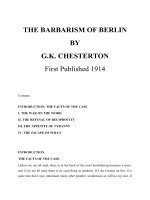THE BASICS OF ECONOMICS pot
Bạn đang xem bản rút gọn của tài liệu. Xem và tải ngay bản đầy đủ của tài liệu tại đây (4.2 MB, 420 trang )
THE BASICS OF
ECONOMICS
David E. O’Connor
GREENWOOD PRESS
The Basics of Economics
Recent titles in
Basics of the Social Sciences
The Basics of Western Philosophy
Eugene Kelly
THE BASICS OF
ECONOMICS
David E. O’Connor
Basics of the Social Sciences
GREENWOOD PRESS
Westport, Connecticut • London
Library of Congress Cataloging-in-Publication Data
O’Connor, David E. (David Edward)
The basics of economics / David E. O’Connor.
p. cm. — (Basics of the social sciences)
Includes index.
ISBN 0–313–32520–0 (alk. paper)
1. Economics. 2. Economics—History. I. Title. II. Series.
HB71.027 2004
330—dc22 2004008304
British Library Cataloguing in Publication Data is available.
Copyright © 2004 by David E. O’Connor
All rights reserved. No portion of this book may be
reproduced, by any process or technique, without the
express written consent of the publisher.
Library of Congress Catalog Card Number: 2004008304
ISBN: 0–313–32520–0
First published in 2004
Greenwood Press, 88 Post Road West, Westport, CT 06881
An imprint of Greenwood Publishing Group, Inc.
www.greenwood.com
Printed in the United States of America
The paper used in this book complies with the
Permanent Paper Standard issued by the National
Information Standards Organization (Z39.48–1984).
10987654321
Contents
List of Figures and Tables vii
Acknowledgments ix
Preface xi
Common Abbreviations in Economics xvii
Timeline of Key Economic Events of the Modern Era: xxiii
1750 to 2005
Chapter 1: Economics as a Social Science 1
Chapter 2: A Survey of Economic History and
Economic Thought 21
Chapter 3: The Rise of Modern Capitalism:
The Power of the Market 47
Chapter 4: The Other Isms: Socialism, Communism,
and Fascism 75
Chapter 5: Business Firms: The Basic Production Unit 105
Chapter 6: Consumers Organize: Consumer Behavior
and Consumer Power 131
Chapter 7: Workers Organize: The Labor Force
and Labor Power 159
Chapter 8: Financial Markets: The Arteries of
Economic Activity 189
Chapter 9: Perspectives on Economic Growth 223
Chapter 10: In Search of Economic Stability 251
Chapter 11: Globalization: Creating a Global
Marketplace 273
Chapter 12: The Challenge of Sustainable Economic
Development 295
Chapter 13: Careers in Economics 319
Appendix A: Glossary of Selected Terms 335
Appendix B: Key Economic Web Sites 351
Appendix C: Selected Videotapes 355
Appendix D: Index to Biographies 361
General Index 365
Contents
vi
List of Figures and Tables
FIGURES
1.1 Production Possibilities Curve for Nation X 5
2.1 Adam Smith Describes the Division of Labor 35
3.1 The Circular Flow Model 54
3.2 Government Workers by Level of Government: 1950–2003 62
4.1 The Pudong New Area 95
6.1 Sources of Household Income: 2003 132
6.2 Household Spending: 2001 133
6.3 Illustrating the Demand for Product X 138
6.4 Illustrating the Supply of Product X 140
6.5 Market Equilibrium for Product X 142
6.6 Price Ceilings and Shortages 143
7.1 U.S. Employment by Sector: 1900 and 2003 161
7.2 The Substitution Effect of a Wage Increase 164
7.3 The Income Effect of a Wage Increase 165
7.4 The Equilibrium Wage 168
7.5 Education and Income: 2000 169
7.6 The Minimum Wage and Labor Markets 172
8.1 The U.S. Money Supply (M1): 2003 192
8.2 Holders of Consumer Credit: 2002 195
8.3 Personal Income, Spending, and Saving: 2003 198
8.4 Commercial Banks and the Fed: 2002 204
8.5 The Dow Jones Industrial Average: 1896 and 2004 209
8.6 Types of Mutual Funds: 2002 213
9.1 Economic Growth: An Illustration 224
9.2 Calculating the Real GDP: 2003 225
9.3 Funding Research and Development: 2000 235
10.1 The Business Cycle Model 252
10.2 Calculating the Inflation Rate: 2002 255
12.1 Population Explosion: 1900–2050 299
13.1 Wages of Social Scientists: 2001 320
TABLES
4.1 Russia’s Performance Indicators: 1995–2004 91
5.1 Top 10 U.S. Corporations: 2003 107
5.2 Forms of Business Organization: 1997 114
5.3 Top 10 Franchises: 2003 115
6.1 Jeremy’s Diminishing Marginal Utility 134
6.2 Domestic Advertising Spending: 2002 Rankings 136
6.3 Major Consumer Organizations 145
6.4 Bankruptcy Filings: 2000–2003 152
7.1 Labor Force Participation Rate: 1900–2003 162
7.2 Education and Employment: March 2003 162
7.3 U.S. Population and the Labor Force: 1950–2010 168
7.4 U.S. Union Membership: 1900–2000 177
8.1 The U.S. Money Supply: 2003 193
8.2 U.S. Depository Institutions: 2002 196
8.3 Outstanding Bond Market Debt: 2003 210
9.1 Calculating the Nominal GDP: 2003 226
9.2 Economic Growth in the Global Economy: 1985–2004 227
9.3 The World’s Largest Economies: 2001 229
9.4 Total Entrepreneurial Activity: 2002 233
9.5 Freedom in the World: 1972–2002 238
10.1 Global Inflation Rates: 1985–2004 254
10.2 Federal Tax Receipts by Category: FY 2004 262
10.3 Budget Surpluses and Deficits: 1980–2009 264
10.4 Distribution of U.S. Money Income: 1975–2000 265
11.1 Top Exporting and Importing Nations: 2002 275
11.2 Exchange Rates: February 23, 2004 276
11.3 Selected Indicators of Transnationals: 1982–2002 277
11.4 Largest Nonfinancial Transnational Corporations: 2001 278
12.1 Classification of the World’s Economies: 2003 296
12.2 Income Distribution in Selected Developing Countries 297
12.3 Selected Quality of Life Indicators: 2001 301
12.4 Official Development Assistance: 2002 310
13.1 Annual Salaries of Business Economists: 2000 323
13.2 Top Salaries in the Federal Government: 2001 327
List of Figures and Tables
viii
Acknowledgments
The author recognizes the following individuals for their contributions to this
publication: Desmond McCaffrey, Instructional Developer at the Institute for
Teaching and Learning, University of Connecticut, for the production of the
book’s charts, graphs, and diagrams; Linda Mathes, Jane White, Jan Nuhn, and
Peter Salesses of the Edwin O. Smith High School Library Media Center for
technical assistance; the Government Publications research staff at the Homer
Babbidge Library, University of Connecticut, for its research support; Anne
Thompson, Senior Development Editor, and Marie Ellen Larcada, Senior Ac-
quisitions Editor, of the Greenwood Publishing Group, for their encouragement,
advice, and guidance; and Liz Kincaid, Photo Researcher, for her assistance in
locating and obtaining photo permissions.
The author recognizes the following organizations and agencies for their
work on behalf of economic education in the United States. Two of the unsung
heroes are the National Council on Economic Education (NCEE) and the Foun-
dation for Teaching Economics (FTE). Over the years their innovative programs
for teachers and students and their instructional materials have advanced the
cause of economic literacy at the elementary, middle, and high school levels.
Deep appreciation is also extended to the National Council for the Social Stud-
ies (NCSS) for its continued support of economic education in the nation’s
schools. Finally, kudos are offered to the many U.S. government agencies and
multilateral organizations that collect and disseminate important economic in-
formation to citizens.
The author recognizes the inspirational work of civil society organi-
zations, which, collectively, work to improve the human condition. Civil society
organizations, including nongovernmental organizations, private foundations,
independent think tanks, charitable groups, and others give a voice to the mar-
ginalized and distressed and raise awareness among all peoples. Royalties
earned from this publication will support Feed the Children, one such group with
ties to the local and the global.
Acknowledgments
x
Preface
It seems that change is the only constant in people’s economic lives. Throughout
history, changes in the human condition have stimulated discussion about how to
best answer society’s basic economic questions of what, how, and for whom to
produce. Over the past two and a half centuries, the economic debates matured.
Professional economists developed and tested theories in the laboratory of ev-
eryday life. Some theories reinforced the status quo, while other fomented rev-
olution. All attempted to explain and influence the economic behaviors of
people.
Today the study of economics is highly scientific. Yet even with cen-
turies of study and the use of sophisticated computer modeling techniques, econ-
omists are unable to untangle some of our most vexing economic mysteries. For
instance, during the 1990s, the U.S. economy reveled in its conquest of inflation
and unemployment. Optimism reigned as the confident nation experienced a de-
cade of economic growth, rising productivity, a raging bull market, and soaring
federal budget surpluses. By the early 2000s, however, the economy soured. Peo-
ple’s confidence dipped as grim reports of recession, joblessness, bearish in-
vestment, massive federal deficits, and crippling corporate scandals dominated
the headlines.
A recurring, if irregular, cycle of economic boom and bust is one of
many dilemmas that economists have grappled with over time. It has been said
that “the owl of Minerva [the ancient Roman goddess of wisdom] takes flight
when darkness has fallen.” Dark economic conditions have traditionally jostled
people’s worldview and have served as a springboard to new economic thinking,
the rise of reform movements, even revolution. The global depression of the
1930s, for example, brought nations and empires to their knees and prompted
momentous changes in the concept of limited government in much of the indus-
trialized world. Depression-era economists such as Frances Perkins and John
Maynard Keynes led the charge to dump the time-honored laissez-faire doctrine
and to radically expand the role of government in promoting economic growth,
stability, and security. Robert Heilbroner often referred to economists as the
“worldly philosophers” to highlight the direct impact of economic thinking on
people’s quality of life. It would be difficult to overstate the role that these
worldly philosophers played in shaping the world’s economic landscape.
Educators, businesspeople, government officials, and others often voice
support for economic literacy as a prerequisite for informed decision making in
today’s fast-paced, complex, and dynamic economy. In recent years, public con-
cern about economic illiteracy stiffened state and federal resolve to raise aca-
demic standards in economics and other core subjects. In 1994 President Bill
Clinton signed into law the historic Goals 2000: Educate America Act (Public
Law 103–227), which identified economics as a core subject in the nation’s
schools. In 2002 President George W. Bush signed the No Child Left Behind Act
(Public Law 107–110), which echoed the Goals 2000 call for mastery of essen-
tial subjects. Under this 2002 legislation, 4 of the 10 core subjects—history, ge-
ography, civics and government, and economics—were nestled beneath the
academic umbrella of historians and social scientists.
The Basics of Economics explores the fundamentals of economic liter-
acy. In language that is clear and precise, this reference guide introduces and ap-
plies the basic economic concepts, analyzes economic choices and decisions,
examines competing theories, traces historical trends and movements, explains
the operation of the U.S. economy, and probes the impact of globalization on the
world economy. Timely, relevant tables, charts, graphs, diagrams, and photo-
graphs reinforce the narrative. In short, this user-friendly reference book pro-
vides a wealth of information to students, teachers, and the public about the
theory and practice of economics.
The book’s front matter consists of three features, each of which facili-
tates quick access to important information. A “List of Tables and Figures” en-
ables users to quickly locate more than 60 tables, charts and graphs, diagrams,
and formulas that accompany the running narrative of the book’s 13 chapters.
These graphics provide timely, authoritative statistical data in a format that in-
vites readers to make economic comparisons and discern economic trends. The
graphics also illustrate economic processes such as economic growth, product
and factor market flows, and price determination. A list of “Common Abbrevi-
ations in Economics” identifies key economic organizations, agreements, insti-
tutions, technologies, and vocabulary from automated clearinghouse (ACH) to
World Wide Web (WWW). A “Timeline of Key Economic Events of the Modern
Era: 1750 to 2005” traces the impact of reform movements, economic theories,
revolutionary actions, government policies, and other events that contributed to
the maturing of economics into a social science. The logical starting point for
the timeline is the life and times of Adam Smith, the founder of modern eco-
nomics.
The Basics of Economics is organized into 13 focused chapters. Chap-
ters 1–4 provide a foundation for the study of economics. Chapter 1, “Econom-
Preface
xii
ics as a Social Science,” defines economics, introduces basic economic vocab-
ulary, outlines an economic way of thinking, and cautions readers about com-
mon fallacies in reasoning. Chapter 2, “A Survey of Economic History and
Economic Thought,” traces the uneven progression of civilizations through four
stages of economic history: primitive food gathering and hunting, agriculture
and animal domestication, manufacturing and the factory system, and the infor-
mation age. It also delves into the rise and fall of several leading schools of eco-
nomic thought, including the mercantilists, physiocrats, classical economists,
marginalists, Marxists, and Keynesians. Later chapters explore other schools, in-
cluding the neoclassical economists, supply-siders, and monetarists. Chapter 3,
“The Rise of Modern Capitalism: The Power of the Market,” and chapter 4, “The
Other Isms: Socialism, Communism, and Fascism,” examine the historical
circumstances that gave rise to revolutionary economic theories and to radical
changes in nations’ economies. These chapters also examine a variety of
twentieth-century economies and the general demise of all isms except capital-
ism by the 1990s.
Chapters 5–8 examine in detail some of the major decision makers in
the microeconomy—businesses, consumers, workers, and financial institutions.
Chapter 5, “Business Firms: The Basic Production Unit,” introduces readers to
the supply side of the market by examining business firms, mainly sole propri-
etorships, partnerships, and corporations. The chapter also delves into business
decision making, the conduct of business operations within different market
structures, and the role of government in protecting competition. Chapter 6,
“Consumers Organize: Consumer Behavior and Consumer Power,” is concerned
with the demand side of the market. The chapter investigates the factors that in-
fluence consumer behavior, including advertising; the growth of consumer
power, including the consumer movement; and market prices, including the in-
teraction of supply and demand. Chapter 7, “Workers Organize: The Labor Force
and Labor Power,” features the role of workers and entrepreneurs in the produc-
tion process. It deals with factors that influence worker behaviors, wage deter-
mination, and the growth of worker power through trade unionism. Chapter 8,
“Financial Markets: The Arteries of Economic Activity,” explores the world of
money and the financial institutions that facilitate saving and investing. The
chapter examines the role of banks, stock exchanges, and other financial insti-
tutions in channeling trillions of dollars into productive investments. It also fea-
tures the expanding role of the Federal Reserve System, the nation’s central
bank, in maintaining the integrity and stability of the American financial sys-
tem.
Chapters 9–10 analyze the performance of the overall economy, or mac-
roeconomy. Chapter 9, “Perspectives on Economic Growth,” explains measure-
ments of economic growth, such as gross domestic product (GDP), and
examines the main economic and political determinants of economic growth in
America and abroad. The chapter also analyzes the costs and benefits of eco-
nomic growth, especially those related to quality of life issues. Chapter 10, “In
Search of Economic Stability,” investigates the types and causes of inflation, un-
Preface
xiii
employment, and recession. The chapter explains how government stabilization
policies, mainly monetary policy and fiscal policy, address disruptive fluctua-
tions in price levels, employment, and national output. It also probes related is-
sues such as taxation and tax policy, federal deficits and the national debt, and
income distribution and poverty.
Chapters 11–12 deal with globalization, economic interdependence, and
the chasm between the world’s rich and poor nations. Chapter 11, “Globaliza-
tion: Creating a Global Marketplace,” examines the three pillars of globaliza-
tion—international trade, foreign direct investment, and cross-border financial
flows. The chapter explores the forces that support the globalization juggernaut,
such as the World Bank, International Monetary Fund, and World Trade Organi-
zation. It also examines dents in globalization’s armor, which include uneven
economic development, vocal discontent of civil society organizations, creeping
protectionism, and the specter of financial contagion. Chapter 12, “The Chal-
lenge of Sustainable Economic Development,” describes the common charac-
teristics of developing countries, the poorer nations of the global south. The
chapter examines the process of economic development and prospects for trans-
forming the vicious cycle of poverty into the virtuous cycle of development.
Chapter 13, “Careers in Economics,” describes current employment op-
portunities for the three types of economists: business economists, academic
economists, and government economists. Economists are professional social sci-
entists who command a wage that is double the average wage for workers in the
American labor force. Many economists earn advanced academic degrees,
which, in the highly competitive job market for economists, is crucial to secur-
ing rewarding positions in the private or public sectors. Holders of degrees in
economics are also attractive candidates for jobs in related occupations such as
market research, advertising, securities dealing, and banking.
Each of the 13 chapters concludes with (1) four or more brief biogra-
phies of people who have been key to the economic issues discussed in that
chapter, with some 55 individuals profiled in total, and (2) a list of useful
sources to consult.
The book’s back matter consists of five handy reference tools. A com-
prehensive “Glossary of Selected Terms” serves as an economics dictionary,
providing readers with quick access to definitions. All terms with definitions in
this glossary are boldfaced within the text. The “Key Economic Web Sites” is a
useful tool for researchers who wish to investigate topics in greater detail or up-
date statistical data. These Web sites connect students, teachers, and other read-
ers with multilateral organizations, such as the United Nations, World Bank, and
International Monetary Fund; U.S. government departments and agencies, such
as the Bureau of Labor Statistics, Bureau of Economic Analysis, and Interna-
tional Trade Administration; and private research groups, such as the Population
Reference Bureau, Freedom House, and World Resources Institute. A “Selected
Videotapes” list provides an overview of classroom-tested audiovisual teaching
aids. An “Index to Biographies” provides an alphabetized list of the 55 individ-
ual biographies that appear in the book. These biographies examine the lives and
Preface
xiv
major contributions of economists and economic thinkers, past and present. The
biographies are clustered by topic within the book’s 13 chapters. For instance,
biographies in chapter 12, “The Challenge of Sustainable Economic Develop-
ment,” offer perspectives on the subject by leading international scholars, in-
cluding British economist Sir Arthur Lewis, Peruvian economist Hernando de
Soto, Indian economist Amartya Sen, and Swedish economist Gunnar Myrdal.
The book concludes with a detailed “General Index,” which enables readers to
locate a specific subject, including multiple references to a subject. Related top-
ics are cross-referenced to facilitate further research.
The study of economics is part art, part science. The basic principles of
economics are derived from ongoing experimentation using computer models
and simulations and other research. Yet the study of economics is grounded in
the real world, a world that refuses to stand still! Changing conditions make the
study of economics a dynamic one that offers fertile ground for new research,
new theories, and new ideas. Not surprisingly, economists’ views often differ,
adding fodder to vigorous public policy debates. The welfare of people, both
local and global, hangs in the balance.
Since the dawn of civilization, people have groped for answers to the
basic economic questions of what, how, and for whom to produce. How people
chose to answer these universal questions shaped the course of history, just as
today’s choices will inevitably affect the quality of life for future generations.
Over time, the ideas of economists have been used to justify the toppling of
nations and empires. They have also helped strengthen existing political and
economic systems and humanize society’s treatment of the poor and other eco-
nomically distressed groups. Sometimes shouted from the barricades, some-
times whispered in the halls of academia, economic ideas have played a central
role framing the institutions, practices, and attitudes of the modern world. The
Basics of Economics attempts to capture the spirit of economics, its fundamen-
tal concepts, its guiding principles, its leading personalities, and its inexorable
journey toward becoming a purer science.
Preface
xv
Common Abbreviations
in Economics
ACH automated clearinghouse
ADB Asian Development Bank
ADB Group African Development Bank Group
AEA American Economic Association
AFL American Federation of Labor
AFL-CIO American Federation of Labor-Congress of Industrial Organizations
ASEAN Association of Southeast Asian Nations
ATM automated teller machine
ATS alternative trading system
B2B business-to-business (transactions)
B2C business-to-consumer (transactions)
BBB Better Business Bureau
BBSS Broker Booth Support System
BEA Bureau of Economic Analysis
BIF Bank Insurance Fund
BIS Bank for International Settlements
BIT bilateral investment treaty
BLS Bureau of Labor Statistics
B/P balance of payments
CBO Congressional Budget Office
CBOT Chicago Board of Trade
CCC Civilian Conservation Corps
CCI Consumer Confidence Index
CCP Chinese Communist Party
CD certificate of deposit
CEA Council of Economic Advisors
CEO chief executive officer
CFA Consumer Federation of America
CFCs chlorofluorocarbons
CFO chief financial officer
CI Consumers International
CIA Central Intelligence Agency
CIO Congress of Industrial Organizations
CIS Commonwealth of Independent States
CME Chicago Mercantile Exchange
CPI consumer price index
CPSC Consumer Product Safety Commission
CR Consumers’ Research
CR continuing resolution
CSO civil society organization
CU Consumer’s Union
CWA Civil Works Administration
DAC Development Assistance Committee
DJIA Dow Jones Industrial Average
Dow Dow Jones Industrial Average
EBRD European Bank for Reconstruction and Development
ECN electronic communications network
ECOWAS Economic Community of West African States
EEOC Equal Employment Opportunity Commission
EIA Energy Information Administration
EMU European Monetary Union
EPA Environmental Protection Agency
ETS Educational Testing Service
EU European Union
FC fixed costs
FDA Food and Drug Administration
FDI foreign direct investment
FDIC Federal Deposit Insurance Corporation
FFIEC Federal Financial Institutions Examinations Council
FICA Federal Insurance Contributions Act
FLSA Fair Labor Standards Act
FOMC Federal Open Market Committee
FTAA Free Trade Area of the Americas
Common Abbreviations in Economics
xviii
FTC Federal Trade Commission
FTZ free trade zone
FX foreign exchange
FY fiscal year
GATT General Agreement on Tariffs and Trade
GDP gross domestic product
GEM Global Entrepreneurship Monitor
GNI gross national income
GNP gross national product
GPT general purpose technologies
GSE government-sponsored enterprise
GSP generalized system of preferences
HDI Human Development Index
HIPC Heavily Indebted Poor Countries (Initiative)
IBRD International Bank for Reconstruction and Development
ICA International Co-operative Alliance
ICSID International Center for Settlement of Investment Disputes
ICTs information and communication technologies
IDA International Development Association
IDB Inter-American Development Bank
IFC International Finance Corporation
ILD Institute for Liberty and Democracy
ILO International Labor Organization
IMF International Monetary Fund
IPO initial public offering
IRA individual retirement account
IRS Internal Revenue Service
IT information technology
ITA International Trade Administration
IWW Industrial Workers of the World
JV joint venture
LLC limited liability company
M&As mergers and acquisitions
MDG Millennium Development Goals
MERCOSUR Common Market of the South
MFN most favored nation (status)
MIGA Multilateral Investment Guarantee Agency
MMDA money market deposit account
MNC multinational corporation
Common Abbreviations in Economics
xix
M1 money supply 1 (measurement 1)
M2 money supply 2 (measurement 2)
M3 money supply 3 (measurement 3)
MTN multilateral trade negotiations
MU marginal utility
NABE National Association for Business Economics
NAFTA North American Free Trade Agreement
NASDAQ North American Stock Dealers Automated Quotations
NBER National Bureau of Economic Research
NCL National Consumers League
NCUA National Credit Union Administration
NCUSIF National Credit Union Share Insurance Fund
NEP New Economic Program
NGO nongovernmental organization
NLRB National Labor Relations Board
NLU National Labor Union
NOW negotiable order of withdrawal
NPL nonperforming loan
NYSE New York Stock Exchange
OCDs other checkable deposits
ODA official development assistance
OECD Organization for Economic Cooperation and Development
OMB Office of Management and Budget
OPEC Organization of Petroleum Exporting Countries
OSHA Occupational Safety and Health Administration
OTC over-the-counter
OTS Office of Thrift Supervision
PIRG Public Interest Research Group
PPC production possibilities curve
PPI producer price index
PPP purchasing power parity
PRB Population Reference Bureau
PRC People’s Republic of China
PRGF Poverty Reduction and Growth Facility
PRWORA Personal Responsibility and Work Opportunity Act
PTA preferential trade agreement
PTO Patent and Trademark Office
R&D research and development
RDB regional development bank
Common Abbreviations in Economics
xx
RTA regional trade agreement
S&L savings and loan association
SAIF Savings Association Insurance Fund
SAR special administrative region
SBA Small Business Administration
SEC Securities and Exchange Commission
SME small and medium-sized enterprises
SOE state-owned enterprise
SRO self-regulating organization
TC total cost
TEA total entrepreneurial activity
TIIS Treasury Inflation-Indexed Securities
TNC transnational corporation
TVE township and village enterprise
UAW United Auto Workers
UFW United Farm Workers
UMW United Mine Workers
UN United Nations
UNCTAD United Nations Conference on Trade and Development
UNDP United Nations Development Program
UNEP United Nations Environmental Program
UNESCO United Nations Educational, Scientific, and Cultural Organization
UNFPA United Nations Population Fund
USAID U.S. Agency for International Development
USSR Union of Soviet Socialist Republics
VC variable costs
WHO World Health Organization
WOFE wholly-owned foreign enterprise
WPA Works Progress Administration
WRI World Resources Institute
WTO World Trade Organization
WWW World Wide Web
Common Abbreviations in Economics
xxi
Timeline of Key
Economic Events of the Modern Era:
1750 to 2005
1760s The physiocratic school of economic thought emerges in France under François
Quesnay, establishing the basis for laissez-faire economics
1770s The classical school of economic thought emerges in Britain under Adam Smith,
author of An Inquiry into the Nature and Causes of the Wealth of Nations (1776)
1791 The First Bank of the United States receives a 20-year charter to support and
strengthen America’s monetary system and credit in global markets
1798 Thomas Malthus publishes An Essay on the Principle of Population as It Af-
fects the Future Improvement of Society, causing some to proclaim economics
as the “dismal science”
1803 Jean Baptiste Say publishes his Treatise on Political Economy, which popular-
izes laissez-faire capitalism and the law of markets, also called Say’s Law
1816 The Second Bank of the United States receives a 20-year charter to stabilize
the money and credit systems of America
1817 David Ricardo publishes Principles of Political Economy, defending free trade
based on the theory of comparative advantage
1832 President Andrew Jackson vetoes legislation that would have extended the
charter of the Second Bank of the United States for another 20 years
1848 Karl Marx and Friedrich Engels publish The Communist Manifesto, a funda-
mental treatise of the Marxist school of economic thought
John Stuart Mill writes Principles of Political Economy, which serves as the
basic economics textbook for the English-speaking world for a generation
1860s Futures contracts for agricultural products are traded at the Chicago Board of
Trade
1867 The first of three volumes of Marx’s Das Kapital is published
1869 The Knights of Labor is founded by Uriah H. Stephens as a secret society of
workers
1870s The marginalist school of economic thought rises under William S. Jevons
(UK), Karl Menger (Austria), Leon Walras (France/Switzerland), and Knut
Wicksell (Sweden)
1876 Thomas A. Edison establishes the world’s first private research laboratory, then
called an invention factory, in Menlo Park, New Jersey
1883 The socialist Fabian Society is founded in Britain; early leaders include Bea-
trice and Sidney Webb and George Bernard Shaw
1886 The American Federation of Labor is founded by Samuel Gompers; the AFL
replaces the Knights of Labor as America’s top labor union
1890 Alfred Marshall publishes Principles of Economics, which becomes the most
widely recognized economics textbook in the world
The Sherman Antitrust Act is enacted to oppose the formation of monopolies
and other restraints on competition
1896 Charles H. Dow creates the Dow Jones Industrial Average, an index of stock
performance based on price fluctuations of a dozen key stocks
1899 The National Consumers League, America’s first national consumer organiza-
tion, is founded
1900 The term economics replaces political economy in common usage
1903 Mary (Mother) Jones leads the march of the mill children to bring national at-
tention to the plight of child labor in America’s textile mills
1905 The Industrial Workers of the World is founded under the slogan “One Big
Union” and openly challenges the capitalist system in the United States
1911 Frederick Winslow Taylor’s book, Principles of Scientific Management, revolu-
tionizes management practices around time and motion principles
1913 The Ford Motor Company introduces the moving assembly line to the produc-
tion of automobiles
The Federal Reserve Act establishes the Federal Reserve System, America’s
central bank
The Sixteenth Amendment to the U.S. Constitution establishes the national in-
come tax
1914 The Clayton Antitrust Act and the Federal Trade Commission Act outlaw anti-
competitive business practices
World War I erupts in Europe, ending the first great age of globalization
1917 Russian Bolsheviks stage a successful communist revolution in Russia under
the leadership of Vladimir I. Lenin
1919 The International Labor Organization is founded to advocate for labor’s rights
in the global economy
1920 Arthur C. Pigou writes The Economics of Welfare, a book that gives birth to a
new branch of economics called welfare economics
1922 The Union of Soviet Socialist Republics (USSR) is formally established as the
world’s first communist country
Benito Mussolini takes control of Italy under the banner of fascism and reor-
ganizes the economy under the corporate state concept
Timeline of Key Economic Events of the Modern Era
xxiv









